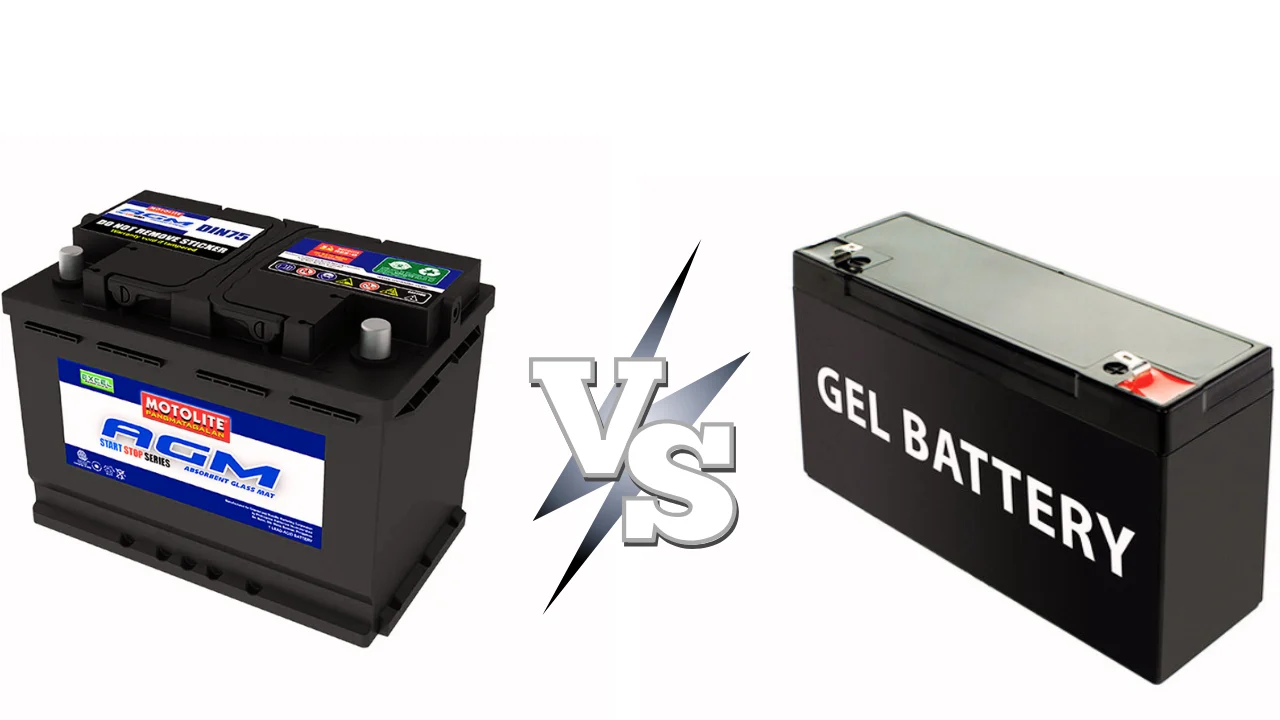Hello everyone, let’s talk about AGM vs Gel battery charging in a simple way. Both batteries are amazing in their own right AGM batteries are perfect for high-power needs like cars and motorcycles, while Gel batteries are great for deep-cycle use, lasting up to 2,000 cycles in RVs or electric wheelchairs.
I’ve used both, and charging them the right way is key to getting the most out of them. Whether it’s the faster charging of AGM or the long-lasting power of Gel, knowing their differences boosts performance and lifespan. Learn more in our guide on the best recommended car battery chargers for top options.
Basics of AGM and Gel Batteries
What is an AGM Battery?

AGM stands for Absorbed Glass Mat. This battery type uses a special fiberglass mat to hold its electrolyte (the liquid that helps it work). Here’s the cool part: AGM batteries are completely sealed and won’t spill even if you tip them over. They’re designed to handle high power demands, like starting your car or running devices that require bursts of energy.
A typical AGM battery can provide 100–200 amps of current, making it ideal for vehicles with start-stop systems, motorcycles, and boats. Plus, they recharge quickly compared to other battery types, highlighting the differences in AGM vs Gel Battery Charging. Learn more in our guide on the best portable electric car battery chargers for reliable options.
What is a Gel Battery?

Now, Gel batteries are a little different. Instead of a liquid electrolyte, they use a thick, gel-like substance made by mixing sulfuric acid with silica. This design gives them extra durability and makes them great for deep-cycle applications, like powering RVs, solar systems, or wheelchairs. When it comes to differences in AGM and Gel battery maintenance, Gel batteries require more careful charging to avoid overcharging, as they operate at a slightly lower voltage range than AGM batteries.
Fun fact: Gel batteries often have a higher cycle life than AGMs, handling 500–700 deep discharge cycles without wearing out. However, they charge slower and need a specific charger to work properly. Learn more in our guide on the best solar car battery chargers with overcharge protection for top recommendations.
Key Differences in Construction and Function

- Electrolyte State: AGM uses liquid absorbed in fiberglass mats, while Gel batteries use a gel-like paste.
- Power Output: AGMs can handle high bursts of power (great for starting engines), but Gels are better for steady, long-term power needs.
- Charging Requirements: Gel batteries are more sensitive to overcharging and need a lower voltage (usually 13.8–14.1V) compared to AGMs (14.2–14.8V).
- Durability: Both are durable, but Gel batteries excel in extreme temperatures and are more resistant to deep discharges.
Key Differences in Charging AGM and Gel Batteries

1. Voltage Requirements
AGM batteries charge at higher voltages compared to Gel batteries. AGM batteries typically require 13.8 to 14.7 volts, while Gel batteries need 13.8 to 14.1 volts due to their sensitivity to overcharging, which can damage their internal gel structure. Learn more in our guide on the best car battery chargers for dead batteries for reliable charging options.
2. Charging Speed
AGM batteries charge faster because they can handle higher currents. For example, an AGM battery with a capacity of 100 amp-hours (Ah) can be charged at a rate of 20-30 amps, making it ideal for quick charging needs. In contrast, Gel batteries require slower charging, usually at 10-15 amps, to protect their longer cycle life.
3. Overcharging Tolerance
Gel batteries are less forgiving when it comes to overcharging. Excess voltage can create bubbles in the gel, leading to permanent damage. AGM batteries are more tolerant due to their absorbed glass mat design, but overcharging still shortens their lifespan, so proper care is essential for both types.
4. Charger Compatibility
AGM batteries are versatile and compatible with most lead-acid battery chargers, provided the charger doesn’t include an “equalization” mode. Gel batteries, on the other hand, require a Gel-specific charger designed to operate at lower voltages to prevent overheating or breakdown. Learn more in our guide on the best NOCO battery chargers for cars for top-rated options.
Common Characteristics of AGM and Gel Batteries

1. Non-Spillable Design
Both AGM and Gel batteries are sealed and designed to be non-spillable. That means even if the battery casing gets damaged, you won’t see any liquid leaking out. This makes them super safe to use, especially in environments where spills could cause damage or safety risks.
2. Maintenance-Free Operation
Who has time for battery maintenance? Luckily, both AGM and Gel batteries don’t require any. No need to top off water levels or worry about corrosion, which is a big plus compared to traditional flooded batteries. This low-maintenance feature makes them great for people who want reliable performance without constant check-ups.
3. Low Self-Discharge Rate
Here’s a neat fact: both AGM and Gel batteries lose charge very slowly when not in use. On average, their self-discharge rate is around 1-3% per month, which is much lower than flooded batteries (they can lose up to 10% per month). This is why they’re ideal for backup power systems or seasonal vehicles like boats and RVs.
4. Flexible Mounting Options
Unlike traditional batteries, AGM and Gel batteries don’t have to sit upright. You can mount them on their side or even at an angle, making them incredibly versatile for tight spaces or unique setups.
5. Safe for Limited Ventilation Areas
Both battery types don’t release gases during normal operation, which means they can safely be used in areas with limited ventilation. Whether it’s in your RV, boat, or even indoors for backup power, these batteries are a safe choice. Understanding how to properly charge AGM and Gel batteries is crucial to maintaining their safety and efficiency in these applications.
6. Deep-Cycle Applications
AGM and Gel batteries are popular for deep-cycle applications, handling repeated discharge and recharge cycles without significant capacity loss. Gel batteries can handle up to 1,000 cycles at 50% depth of discharge, while AGM batteries typically manage around 500 cycles. Learn more in our guide on the best portable car battery chargers for reliable charging solutions.
AGM Batteries: Features and Performance

- Absorbed Glass Mat Design: AGM (Absorbed Glass Mat) batteries use fiberglass mats to hold the liquid electrolyte, making them spill-proof and maintenance-free.
- High Current Delivery: Excellent for high amp bursts, ideal for starting applications in vehicles like cars, motorcycles, and ATVs.
- Durable Under Load: Performs well under heavy loads at lower depths of discharge, maintaining stable performance for up to 500 cycles at 50% depth of discharge, with premium brands reaching 1,000+ cycles.
- Vibration Resistance: Designed to handle vibrations, making them great for off-road vehicles and boats.
- Low Self-Discharge: Self-discharge rate is minimal, allowing for long storage without significant power loss.
- No Corrosion or Gassing: AGM batteries are sealed, preventing off-gassing and corrosion, making them safe for use in enclosed spaces.
- Fast and Easy Charging: Can be charged using standard chargers or alternators, typically requiring 14.2–14.6 volts for optimal performance.
- Best Applications: Perfect for start-stop vehicles, high-power-demand systems, and applications where durability and reliability are critical.
Gel Batteries: Features and Performance

- Unique Gel Electrolyte: Gel batteries use a thick, jelly-like electrolyte made from sulfuric acid and silica, giving them durability and versatility.
- Deep Cycling Power: Ideal for repeated deep discharges, with 500-800 cycles at 50% depth of discharge; premium models can go up to 1,000 cycles.
- Temperature Performance: Performs well in both freezing and hot conditions, aging slower in warmer climates and offering freeze resistance.
- Low Self-Discharge: Holds charge efficiently during storage with a self-discharge rate of just 1-3% per month.
- Slightly Lower Capacity: Typically provides 88 AH for a Group 27 battery, slightly less than the 92 AH from an AGM of the same size.
- Charging Sensitivity: Requires a gel-specific charger with voltage settings around 13.8–14.1 volts; incorrect charging can damage the gel.
- Best Applications: Perfect for deep-cycle needs like RVs, marine equipment, and mobility devices where slow discharge and long life matter most.
Charging AGM Batteries

AGM batteries charge easily with standard chargers or alternators. Use a voltage range of 14.4–14.8 volts for the bulk stage. Once at 80% charge, the charger switches to absorption mode, where the current slows down. A 100Ah AGM battery takes about 10 hours with a 10-amp charger. If your charger has an “AGM mode,” use it to avoid unnecessary equalization. Keep the temperature between 20°C–25°C for best results.
Charging Gel Batteries

Gel batteries are more delicate and need a charger specifically for Gel types. They charge at 13.8–14.1 volts, as higher voltages can damage the gel. A 100Ah Gel battery may take 12–14 hours with a 10-amp charger. Avoid standard chargers to prevent overcharging. When considering AGM vs Gel Battery Performance and Lifespan, Gel batteries excel in deep-cycle durability but require precise charging. Keep the charging environment around 20°C–25°C and use temperature-compensated chargers for better safety and performance.
Practical Maintenance Tips

- Charge Properly
- AGM Batteries: Use standard chargers or alternators. Avoid chargers with equalization mode. Ideal voltage: 14.4–14.8V.
- Gel Batteries: Use gel-specific chargers. Ideal voltage: 13.8–14.1V. Wrong chargers can cause overheating.
- Avoid Deep Discharges
- AGM: Keep discharge at 50% or less for 500–1,000+ cycles.
- Gel: Stick to 50–60% depth of discharge (DoD) for longer life.
- Control Temperature
- High temperatures reduce lifespan by 50% for every 10°C (18°F) increase. Store in cool, ventilated spaces.
- Store Correctly
- Fully charge before storage. Recharge if voltage drops below 12.6V (AGM) or 12.8V (Gel) every 2–3 months.
- Clean Terminals
- Use a mix of baking soda and water to clean. Apply petroleum jelly to prevent corrosion.
- Use Multi-Type Chargers
- Multi-type chargers adjust voltage automatically, protecting both AGM and Gel batteries.
Conclusion
Proper care ensures long-lasting performance in AGM vs Gel Battery Charging. Use the right chargers, avoid deep discharges, and maintain ideal temperatures. Regularly clean terminals and store batteries correctly to prevent damage. By following these steps, you’ll maximize battery lifespan and efficiency, keeping your power solutions reliable for years.
FAQs
Q1: What is the key difference between AGM and Gel battery charging?
AGM batteries charge at a higher voltage (14.4–14.8V) and can use standard chargers, while Gel batteries need a lower voltage (13.8–14.1V) and a gel-specific charger to avoid overheating and damage.
Q2: Can I use the same charger for AGM and Gel batteries?
No, using the same charger for both can harm Gel batteries. Gel batteries require a gel-specific charger due to their lower charging voltage. A multi-type charger is ideal if you use both types.
Q3: What happens if I use the wrong charger for Gel batteries?
Using the wrong charger, such as one designed for AGM, can overheat the gel electrolyte in Gel batteries, causing permanent damage and reducing their lifespan.
Q4: How can I extend the lifespan of AGM and Gel batteries?
Follow proper charging guidelines, avoid deep discharges, store them in cool, dry places, and keep the terminals clean. Regular maintenance will ensure optimal performance and longevity for both battery types.




